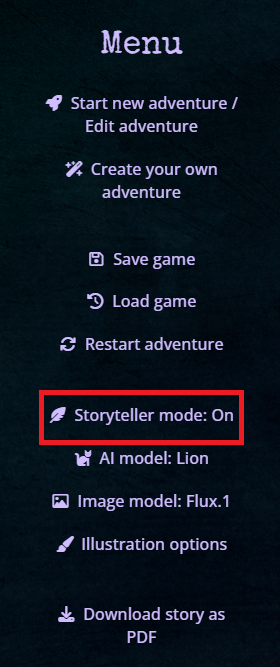Storyteller Mode
Storyteller Mode is an option you can toggle from the main Menu while playing a game. When you turn it on, it adds several new buttons to your interface, just above where you select your input for that turn.
Effects of Storyteller Mode[edit]
Enabling Storyteller Mode unlocks several new options:
- You can see tracked items that are normally invisible to the player (by clicking the Lock icon)
- You to see the secretInfo for that turn (by clicking the eye icon)
- You can edit the current turn (by clicking the pencil icon)
- You can edit the entire design of the in-progress world (by clicking the pencil icon)
- It adds a new input box at the bottom of the page labeled and/or tell the AI what should happen next:. When you enter information in this box, it is passed to the storytelling AI, but as an out-of-character instruction (it works the same way as a trigger that gives information to the AI).
Uses for Storyteller Mode[edit]
Viewing Hidden Tracked Items[edit]
Does what it sounds like: at any time you can simply click the lock to see the value of every tracked item, including those that are normally hidden from the player. Invaluable for debugging a world you're creating.
Editing the Current Turn[edit]
By clicking the pencil, you get a box that lets you simply edit the entire text -- playerAction, outcomeDescription, and secretInfo -- of the current turn. You can use this to make tweaks both big and small to the turn. Because the entire text of the current turn is always sent to the AI for the next turn, changes you make here will be considered as truth by the AI when it generates the next turn. Some things you can do with this:
- Allow yourself to succeed in something the AI determined you failed at (or vice versa)
- Fix inconsistencies, e.g. if the AI forgot or hallucinated some detail, you can edit the turn to fix it
- Remove plot twists you do not want to occur
- Insert text to remind the AI about things it has forgotten
And many more. Note that text in secretInfo carries more weight for the AI than in outcomeDescription, so if you really want something to "stick" in long-term memory, you are best served by making sure it appears in secretInfo.
Editing World Design[edit]
By clicking the pencil icon, you get the interface to edit the current turn, and then you can click "View/edit world design" link button to be able to view/edit the entire design for a world that you're currently playing. This functions almost exactly like World editing does normally with a few exceptions:
- Any changes you make to player characters or "Other characters" won't have any effect at all on the current playthrough.
- Newly added tracked items won't appear in the game.
- The effects of any triggers which have already fired won't be changed
Otherwise, you can add/edit/remove instructions and extra instruction blocks, add triggers that will fire in the future, change author style or description/summarization instructions, etc. This is extremely powerful and allows you to completely tailor the current world to better suit your preferences (it is also useful when playtesting a world you are building).
One important caveat is that any changes you make to a currently-running world are not propagated anywhere. If you stop playing the world, the changes are gone (though saving and loading the world will persist your changes). In other words, if you created a world, started a playthrough of it, edited it via storyteller mode, and exit the world, the changes will not affect the world you originally created.
If you want to persist your changes, you have two basic options:
- You can choose Save as new world at the bottom of the world editor. This will save the current design as a new world in Your Worlds.
- Otherwise, you need to copy/paste changes manually from your current instance to the world you want to permanently modify. You can use the JSON Import Tool to do this quickly.
Reading secretInfo[edit]
The secretInfo field is very illuminating about what the AI is thinking, as it contains information about things NPCs know that the player does not. It is also frequently where the AI introduces new plots, so paying attention to secretInfo can be useful if you want to avoid or encourage specific plots or twists. If you are testing a world you have authored, looking at secretInfo can be valuable for troubleshooting and debugging things.
Giving Information to the AI[edit]
This is a text input box that gives information directly to the AI. It is similar to an instruction that only persists for a single turn and is identical in function to the trigger effect with the same name. If you want something to happen next turn, this acts as a sort of override -- you can just tell the AI what should happen and not worry about whether it follows the normal rules for things like skill checks. You can also use it to tell the AI what NPCs should do or just to describe events that are outside of your player character's control.
Another use is to give the AI instructions that are not directly related to the story, e.g. you can tell it to print something in secretInfo. If you've forgot some character detail and want to know what the AI remembers, you can give it an instruction like "Print my character's age in secretInfo" and it generally will honor this. This a very powerful feature with many possible uses.
